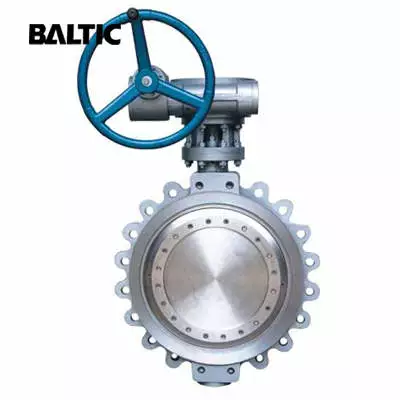Application of triple offset two-way hard sealing butterfly valves
At present, butterfly valves are widely used in many fields, such as petroleum, chemical industry, metallurgy and water and electricity as a component used to realize the on-off and flow control of pipeline systems. In the known butterfly valve technology, the sealing form is mostly sealed, and seal material is rubber, PTFE, etc. Due to structural limitations, it is not suitable for industries such as high temperature, high pressure, corrosion, and wear resistance. A relatively advanced butterfly valve is a triple offset metal hard sealing butterfly valve, the valve body and seat are jointed together, and the sealing surface layer of the valve seat is welded with a temperature-resistant and corrosion-resistant alloy material. The multi-layer soft stack sealing ring is fixed on the valve plate. Compared with the traditional butterfly valve, this butterfly valve has the advantages of high temperature resistance, convenient operation, no friction when on and off and long service life. When closed, the sealing was compensated with the increase of torque of the actuator, improving the sealing performance of the valve and extending the service life. However, the butterfly valve still has the following problems during use:
- 1. As the multi-layer soft and hard stack sealing ring is fixed on the valve plate, when the valve plate is normally open, the media will form a front flush on the sealing surface thereof,. After the soft sealing belt in the interlayer of metal plate is flushed, the sealing performance will be directly affected.
- 2. Restricted by structural conditions, this structure is not suitable for valves with a diameter less than DN200, because the overall structure of the valve plate is too thick and the flow resistance is high.
- 3. Due to the principle of the structure of triple offset butterfly valves, the valve plate is pressed against the valve seat by the torque of the transmission device, then the seal forms between the sealing surface of the valve plate and the valve seat. In the positive flow state, the higher the medium pressure, the tighter the seal extrusion. When the flow medium is reversed, seal leakage begins when the unit positive pressure between the valve plate and seat is less than the medium pressure as the medium pressure increases.
The utility model aims to provide a high performance triple offset two-way hard sealing butterfly valve with zero leakage, flexible opening and closing, long service life, high temperature resistance, high pressure resistance, corrosion resistance and wear resistance.
A high-performance triple offset two-way hard sealing butterfly valve is characterized in that the valve seat insert is composed of a plurality of layers of stainless steel sheets on both sides of a soft T-shaped sealing ring. The sealing surface of the valve plate and seat is an oblique conical structure, the temperature-resistant and corrosion-resistant alloy material is welded on the inclined conical surface of the valve plate, and the spring fixed between the adjusting ring pressure plate and the adjusting bolt assembly on the pressure plate are assembled. This structure effectively compensates the tolerance zone between the sleeve and the valve body and the elastic deformation of the valve stem under the medium pressure, solving the sealing problem of the valve in the two-way interchangeable medium conveying process.
The sealing ring is composed of multi-layer stainless steel sheet on both sides of flexible T-shaped, which has the double advantages of metal hard seal and soft seal, and has zero leakage sealing performance at low temperature and high temperature.
The test proves that the pressure on the sealing surface is generated by the torque of the transmission device and the action of medium pressure on the valve plate in the positive flow state of the tank (the flow direction of medium is the same as the rotation direction of the disc). When the pressure of positive medium increases, the tighter the extrusion between the oblique conical surface of the valve plate and the sealing surface of the valve seat, the better the sealing effect.
When in reverse flow mode, the valve plate is pressed against the seat by the torque of the actuator, then the seal forms between the valve plate and seat. As the pressure of the reverse medium increases, the unit positive pressure between the valve plate and the seat is less than the pressure of the medium, and the deformation of the spring of the adjusting ring after being loaded can compensate the tight pressure of the sealing surface of the valve plate and the valve seat, which plays an automatic compensation role. Therefore, the utility model does not install soft and hard multi-layer sealing rings on the valve plate as in the prior art, but directly installs them on the valve body. Adding adjustment ring between the pressure plate and the seat is a very ideal mode for two-way hard sealing. Hence, the triple offset two-way hard sealing butterfly valves will replace gate, globe and ball valves.

Previous: 14 taboos of installing a valve (Part Four)
Next: Major Types and Installation of Steam Traps or Drain Valves
Next: Major Types and Installation of Steam Traps or Drain Valves




